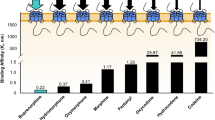Abstract.
Rationale: Drug discrimination assays can provide important information on receptor selectivity and relative efficacy to guide the classification and characterization of opioid agonists. Objectives: A three-choice discrimination was established among high efficacy opioid agonist morphine, low efficacy opioid agonist nalbuphine, and saline to examine the conditions under which differences in relative efficacy might serve as a basis for stimulus control. Methods: Seven White Carneau pigeons were trained to discriminate among 5.6 mg/kg nalbuphine, 3.2 mg/kg morphine, and saline under fixed ratio 30 (FR30) schedules of food reinforcement. Substitution and antagonism experiments were then conducted with µ, κ, and δ opioids and naltrexone, respectively and the percent responding appropriate to the training stimuli was determined. Results: Low, intermediate, and high doses of morphine produced ≥80% saline-, ≥60% nalbuphine-, and ≥96% morphine-appropriate responding, respectively. Low and high doses of nalbuphine produced ≥80% saline- and nalbuphine-appropriate responding, respectively. In substitution tests, low doses of fentanyl and etorphine produced partial nalbuphine-appropriate responding (20–60%) and high doses produced ≥60–80% morphine-appropriate responding. Intermediate doses of buprenorphine and dezocine produced ≥60–80% nalbuphine-appropriate responding and high doses produced ≥80% morphine-appropriate responding. The lower efficacy agonists butorphanol, nalorphine, and levallorphan produced ≥40–80% nalbuphine-appropriate responding. The κ agonists spiradoline and U50,488 produced approximately ≥50% nalbuphine-appropriate responding whereas d-amphetamine, saline, and δ agonists BW373U86 and SNC 80 produced ≥80% saline-appropriate responding. Naltrexone produced ≥80% saline-appropriate responding and reversed the stimulus effects of morphine and nalbuphine. Conclusions: The discrimination between morphine and nalbuphine in pigeons is predominantly based on the relative efficacy differences between morphine, a higher-efficacy µ agonist and nalbuphine, a lower-efficacy µ agonist.
Similar content being viewed by others
Author information
Authors and Affiliations
Additional information
Electronic Publication
Rights and permissions
About this article
Cite this article
Walker, E.A., Picker, M.J. & Dykstra, L.A. Three-choice discrimination in pigeons is based on relative efficacy differences among opioids. Psychopharmacology 155, 389–396 (2001). https://doi.org/10.1007/s002130100714
Received:
Accepted:
Issue Date:
DOI: https://doi.org/10.1007/s002130100714



